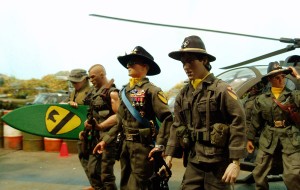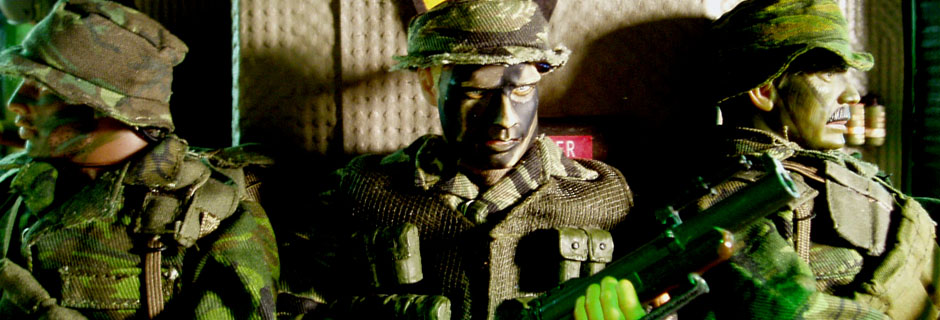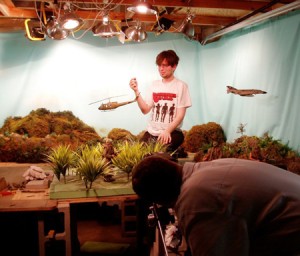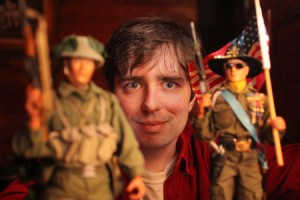WAR IS HELL: VIVA THE ‘NAM
WAR IS HELL: Kieran Healy on his 8-years-in-the-making stop-motion war epic VIVA THE ‘NAM
After nearly a decade in the making, Paul Hanley and Kieran R. Healy’s insanely labour-intensive 1/6 scale feature-length 16mm Vietnam war epic Viva the ‘Nam is finally available for viewing in segments on the pair’s Youtube Channel (HERE)
To summarize the obsessive Austin, TX production in one sentence: In admonishing his enlisted son about the perils of war, retired Marine and Vietnam vet Joe Holmes (who looks suspiciously like a certain Lucasfilm rascal) recalls his turbulent time in Vietnam as part of the “Bastard Squad” – a group of overtly exaggerated war film stereotypes, complete with all the racist, sexist and homophobic humour that characteristically entails. Descending into shell-shock hell, Holmes and his comrades go on nihilistic killing sprees, becoming more alienated by the day, all the while being filmed by an ambitious auteur who wants capture the magnificence of war on film. While sometimes shocking in its political incorrectness, the film is above all a satire meant to point out the absurdity in looking at war as a pursuit associated with any kind of glory.
The film has had surprisingly little festival exposure, which may be linked to copyright issues. Plastered with wall-to-wall 60s hits that will probably never make it past a copyright lawyer, there is another reason this labour of love will always be relegated to the underground: celebrity action figures. Scouring the earth (or more specifically, Japan) for obscure action figures, it’s amazing who they came upon for cameo roles: Lou Reed, Beyond the Valley of the Dolls’ Ronnie ‘Z-Man’ Barzell, Arnold Schwarzenegger, Charles Manson, Hunter S. Thompson and more, as well as meatier roles for war genre titans R. Lee Ermey and the Duke himself.
In-jokes abound, with war films from Apocalypse Now to M*A*S*H getting a nod, alongside references to cult films like Repo Man (note the ‘Helping Hand Acceptance Corporation’), The Running Man and more. The audience is repeatedly thrown off by the blend of dark subject matter and over-the-top vocal delivery (courtesy of the filmmakers and a handful of friends, including miniature FX man Lee Sparks and film programmer/filmmaker Spencer Parsons ) which creates the kind of uncomfortable contrast that cult films are made of.
Co-creator Kieran Healy was kind enough to offer the inside scoop on what it was like making the Vietnam War fit onto a single 9-foot construction table.
——————–
I’ve heard varying reports on how long the film took to make. How many years did it actually take? Can you describe the timeline of creating the film?
Removing time off for when I was out of town for a time, or Paul was out of town, or it just got too damn hot in that garage in the summer, I’d say total time spent was 7-8 years. Here’s the basic progression of how the movie was made:
2000-2002 – Getting our bearings, doing research and generating ideas. Essentially, Paul writes a treatment and we build a set and start shooting on it. After a bit we realize the treatment Paul wrote would take hours and hours to watch, so we scale it down. That’s right, you saw a scaled down version of what we had planned.
2003 – 2006 – Paul and I hammer out a story from beginning to end and start shooting it for real. I’m talking 5-6 nights a week, sometimes overnight, on top of a normal day job. There were days where I was driving to Paul’s house in Cedar Park after work and coming home to East Austin sometime around 3 in the morning. Or, when I didn’t have a car, Paul would have to drive me home.
2006-2007 – Paul sits down and writes the physical script, so we have the lines people will speak, and we start gathering friends and relatives to help us with voicework. I start up on editing.
2007 – 2010 – Editing and sound design. I discovered why there is a reason there are multiple people for editing, sound design and sound editing. IT’S HARD! And it takes a long time to get right! On top of that, I moved to New York to start working in television, so Paul and I collaborated over the internet. I would upload segments of the movie and he would give me notes and what worked and what didn’t.
One thing about this movie and how long it took. It took a long time, and it started as a showcase for Paul’s talents and my abilities and what we can do creatively. But once you invest so much time from the beginning, you hit a point of no return. What is the difference between 6 years and 10? It’s only time wasted if we gave up and it never saw the light of day.
Another idea that’s interesting to me is that this movie is the product of our learning process. We didn’t know what the hell we were doing at the beginning. To think of the mistakes we made, and to know at the beginning what we know now about the entire process, I can only imagine what kind of movie we COULD have made. Then again, if you told me it would take 10 years, I would have said “Forget it. I don’t care how cool it is.”
 What was the most time-consuming element of the production?
What was the most time-consuming element of the production?
Setting up shots with aircraft. By far. To get them to fly through frame in a realistic fashion took a lot of planning and setup. Plus, particularly with Helicopters which required very particular single-frame movements, it takes a long time to animate. We did one shot for War American Style with tons of biplanes that took over 5 hours to setup and another several to shoot, and compromised approximately 3 seconds of footage. We never tried anything that complex again.
The next would be anything involving a tracking shot. Moving the camera in time with moving vehicles or characters required a lot of concentration and keeping framing as correct as physically possible.
When did the finished film first screen, and what was the reaction?
January of last year, we started screening it in Austin, TX to see how it would go over. The response was amazing. I breathed a sigh of relief when we got a standing ovation at the Alamo Draftouse. We shot it for viewing in a crowded theater, and it works incredibly well in that venue. Also, they gave us a bigger theater than Wanted and we packed it. So that was a fun moment.
Tell me a bit about the team that worked on the film and what their different roles were.
Paul Hanley Kieran R. Healy: Co-Creators. Essentially, we did all the animation ourselves. We did get occasional help from other film folks in Austin, particularly Everett Aponte (who also provided a mic and mixer for additional ADR work) and Charles Sweatt among others. Otherwise it was myself and Paul baking under 6000 watts of light in an un-airconditioned garage. Or in my apartment pouring over footage and sound effects while editing through the night (and next day and night).
Paul Hanley: Writer, Director, Set Design, Concept Art, Overall Creative Guru
Kieran R. Healy: Cinematographer, Editor, Sound Design, After Effects, Titles, Overall Technical Guru
Lee Sparks: Custom Action Figure designs, additional material contribution (Lee had some really great ideas that we incorporated into the movie)
Stephen Ceresia: Dialogue/ADR recording. Here is his studio: http://www.sundayhouse.org/
Without his assistance, a lot of our dialogue would have been recorded on sub-standard equipment in my bedroom.
That is it. We had friends and family that were instrumental in their support and occasional help in construction of sets when they could. But it’s hard to expect people to take as much time out of their lives as we have for little more than lunch and our deepest thanks. Additionally, everyone who helped come in and do the voicework for free is tops on our list. Everett nearly ruined his voice on some of those characters.
What was the evolution from your first stop-motion war film “War American Style” and Viva the Nam’? What kinds of things did you learn on the first film that you applied to ‘Viva’?
Mostly it was little things like gluing down things that aren’t supposed to move, or that certain lighting styles didn’t work. Set design, while great on War American Style, vastly improved through Viva. WWI in War American Style set the standard for scope, mixed scale, feel and lighting, as well as confidence in rolling with creative ideas and building the best sets possible. From there we created entire Laotian villages, airports, tiger cages and forests that look fantastic.
Tricks of the Trade: The basic set-up for the studio (aka garage) where we shot this was plywood table, approximately 7 ft. x 9 ft, with trap doors so we could animate background material and aircraft. We built rigging out of 2x4s and hung 500 watt Halogen worklights for key lighting, and then all kinds of other lights for fill. The basic goal was 1) To re-create that late 60’s film color and feel as much as we could. 2) Make it look as hot and humid as possible. Since action figures don’t sweat it really had to come through with set design and lighting.
Mixed Scale: To force perspective we would mix scales as much as possible. For instance, a 12 inch (1/6th scale) figure in the foreground could have a 1/18th scale helicopter flying in the background, and then a 1/72 scale helicopter behind that. Suddenly, it looks like you have two helicopters flying in formation from a distance, when in reality they are only a yard or so behind the character in the foreground.
Marc Savlov pointed out in the Austin Chronicle that the Vietnam War hasn’t been the setting for many comedies – other wars, sure, but Vietnam remains relatively untouched. Why do you think that is?
No idea. There’s so much material, and not in a cynical way, either.
The film is such a weird mixture of a child’s backyard toy fantasy and some very dark humour – dealing with things such as combat shock and human war trophies. Where did you create your own personal line in terms of where to go or not go with the humour?
Essentially, we determined that if it wasn’t funny to us, it wouldn’t be to anyone else either. We never had a line that said “Do Not Cross.” I have family in the military and they have different reactions to different jokes, so there really isn’t a line to cross. There are jokes in there I am uncomfortable with, but know that they are funny many other people and that is what is most important. Who knows, maybe in 10 years I’ll look at something and wonder why I thought it wasn’t funny or vice-versa. Some jokes I was concerned with falling flat didn’t, and in fact brought roars of laughter. Fortunately, there are no jokes I find hilarious that others didn’t.
————–
Interview by Kier-La Janisse

 June 1, 2011
June 1, 2011 






I just wanna say this is the best stop motion ever. Loved reading what happened behind the scenes.
6 yearss ago